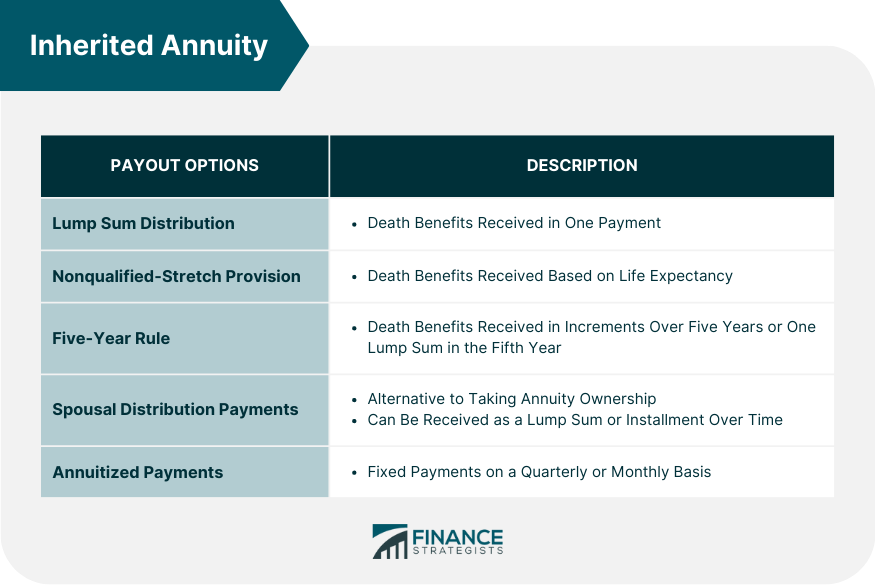All Categories
Featured
Table of Contents
This five-year general policy and 2 adhering to exemptions use just when the owner's death sets off the payment. Annuitant-driven payments are talked about below. The initial exemption to the basic five-year guideline for specific recipients is to approve the survivor benefit over a longer period, not to surpass the expected life time of the beneficiary.
If the beneficiary elects to take the death benefits in this technique, the advantages are strained like any other annuity repayments: partially as tax-free return of principal and partly taxable earnings. The exemption proportion is found by making use of the dead contractholder's price basis and the anticipated payouts based upon the beneficiary's life span (of shorter period, if that is what the recipient selects).
In this technique, often called a "stretch annuity", the recipient takes a withdrawal annually-- the called for amount of each year's withdrawal is based upon the very same tables utilized to determine the required circulations from an individual retirement account. There are two benefits to this technique. One, the account is not annuitized so the recipient keeps control over the cash money value in the contract.
The second exception to the five-year policy is available only to a making it through partner. If the marked beneficiary is the contractholder's partner, the partner may choose to "tip right into the footwear" of the decedent. In impact, the spouse is dealt with as if she or he were the proprietor of the annuity from its beginning.
Tax on Fixed Income Annuities death benefits for beneficiaries
Please note this applies only if the partner is called as a "marked recipient"; it is not offered, for example, if a count on is the recipient and the spouse is the trustee. The general five-year rule and both exceptions just put on owner-driven annuities, not annuitant-driven contracts. Annuitant-driven contracts will certainly pay death benefits when the annuitant dies.

For purposes of this discussion, presume that the annuitant and the proprietor are various - Retirement annuities. If the agreement is annuitant-driven and the annuitant passes away, the death causes the death benefits and the recipient has 60 days to make a decision how to take the fatality advantages subject to the terms of the annuity contract
Also note that the option of a partner to "step into the shoes" of the owner will certainly not be offered-- that exemption applies just when the owner has died but the proprietor didn't die in the instance, the annuitant did. If the recipient is under age 59, the "death" exemption to prevent the 10% charge will not use to a premature circulation again, because that is readily available just on the death of the contractholder (not the fatality of the annuitant).
Actually, several annuity firms have interior underwriting plans that reject to provide contracts that name a different owner and annuitant. (There may be strange situations in which an annuitant-driven contract fulfills a customers special needs, but generally the tax negative aspects will certainly surpass the advantages - Immediate annuities.) Jointly-owned annuities may posture similar troubles-- or at the very least they may not offer the estate preparation feature that jointly-held assets do
Consequently, the survivor benefit have to be paid within five years of the very first proprietor's death, or subject to the 2 exemptions (annuitization or spousal continuation). If an annuity is held jointly in between a couple it would certainly show up that if one were to die, the other might just proceed ownership under the spousal continuation exception.
Assume that the couple named their son as recipient of their jointly-owned annuity. Upon the death of either owner, the company has to pay the survivor benefit to the kid, who is the beneficiary, not the surviving spouse and this would possibly beat the proprietor's purposes. At a minimum, this instance points out the complexity and uncertainty that jointly-held annuities posture.
Tax treatment of inherited Annuity Income Riders
D-Man created: Mon May 20, 2024 3:50 pm Alan S. composed: Mon May 20, 2024 2:31 pm D-Man created: Mon May 20, 2024 1:36 pm Thank you. Was really hoping there might be a system like setting up a beneficiary IRA, however appears like they is not the situation when the estate is configuration as a recipient.

That does not identify the type of account holding the acquired annuity. If the annuity was in an inherited IRA annuity, you as administrator should have the ability to assign the acquired individual retirement account annuities out of the estate to inherited IRAs for each and every estate recipient. This transfer is not a taxed occasion.
Any kind of circulations made from inherited Individual retirement accounts after job are taxed to the recipient that obtained them at their common earnings tax rate for the year of distributions. If the inherited annuities were not in an IRA at her fatality, then there is no method to do a direct rollover right into an inherited Individual retirement account for either the estate or the estate recipients.
If that takes place, you can still pass the distribution via the estate to the private estate recipients. The tax return for the estate (Kind 1041) can include Type K-1, passing the revenue from the estate to the estate beneficiaries to be strained at their individual tax obligation prices as opposed to the much greater estate earnings tax prices.
Are inherited Annuity Income taxable income

: We will create a plan that consists of the most effective items and features, such as boosted survivor benefit, premium benefits, and permanent life insurance.: Receive a personalized method made to optimize your estate's value and minimize tax obligation liabilities.: Carry out the chosen method and get continuous support.: We will certainly assist you with establishing the annuities and life insurance coverage plans, offering constant assistance to make certain the plan remains effective.
Must the inheritance be concerned as a revenue connected to a decedent, after that tax obligations may use. Generally speaking, no. With exception to retired life accounts (such as a 401(k), 403(b), or individual retirement account), life insurance policy earnings, and savings bond passion, the beneficiary normally will not need to bear any type of earnings tax on their inherited wealth.
The quantity one can acquire from a trust fund without paying tax obligations depends on numerous aspects. Specific states might have their own estate tax guidelines.

His goal is to streamline retirement preparation and insurance policy, ensuring that customers recognize their selections and secure the best insurance coverage at irresistible prices. Shawn is the creator of The Annuity Professional, an independent on-line insurance coverage firm servicing customers across the United States. Via this platform, he and his group objective to get rid of the uncertainty in retirement planning by helping individuals discover the very best insurance policy protection at the most affordable rates.
Table of Contents
Latest Posts
Decoding How Investment Plans Work Everything You Need to Know About Financial Strategies Defining the Right Financial Strategy Advantages and Disadvantages of Different Retirement Plans Why Indexed A
Highlighting the Key Features of Long-Term Investments A Closer Look at How Retirement Planning Works What Is the Best Retirement Option? Benefits of Choosing the Right Financial Plan Why Fixed Annuit
Highlighting Fixed Indexed Annuity Vs Market-variable Annuity A Comprehensive Guide to Investment Choices Breaking Down the Basics of Investment Plans Pros and Cons of Various Financial Options Why Ch
More
Latest Posts